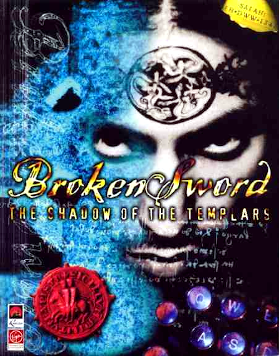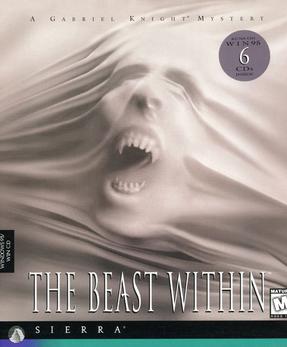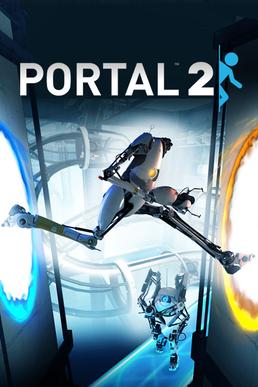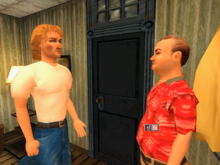Gabriel Knight is a series of point-and-click adventure games released by Sierra On-Line in the 1990s created by Jane Jensen. The titular character is an author and book store owner in New Orleans who is investigating a strange series of murders when he learns he is descended from a long line of Schattenjäger. After undergoing a spiritual trial, Gabriel becomes the new Schattenjäger, called on to stop those who use supernatural methods to threaten others. To signify this, he wears the Ritter Talisman, a protective medallion. Not having supernatural abilities himself, Gabriel mainly opposes his enemies with cunning and insight after investigation and research. In the first game, he is assisted by Grace Nakimura. In the two sequels, the two act as partners against evil, with Grace being a playable character.
An action-adventure game is a video game hybrid genre that combines core elements from both the action game and adventure game genres.
Jane Jensen is an American video game designer and author. She is mostly known as the creator of the Gabriel Knight series of adventure games, and also co-founded Oberon Media and Pinkerton Road video game development companies. Jensen also writes under the name Eli Easton.
Game Developer is a website created in 1997 that focuses on aspects of video game development. It is owned and operated by Informa and acted as the online sister publication to the print magazine Game Developer prior to the latter's closure in 2013.

Goichi Suda, known by his alias Suda51, is a Japanese video game designer, writer and director. Affiliated with Human Entertainment from 1994 to 1998, he founded Grasshopper Manufacture in 1998 with a number of other Human Entertainment staff to produce their own titles. His best-known work has come from Grasshopper Manufacture, including The Silver Case (1999), Killer7 (2005), the No More Heroes series, and Lollipop Chainsaw (2012).

King's Quest VI: Heir Today, Gone Tomorrow is a point-and-click adventure game, first released in 1992 as the sixth installment in the King's Quest series produced by Sierra On-Line. Written by Roberta Williams and Jane Jensen, King's Quest VI is widely recognized as the high point in the series for its landmark 3D graphic introduction movie and professional voice acting. King's Quest VI was programmed in Sierra's Creative Interpreter and was the last King's Quest game to be released on floppy disk. A CD-ROM version of the game was released in 1993, including more character voices, a slightly different opening movie and more detailed artwork and animation.

Broken Sword: The Shadow of the Templars is a 1996 point-and-click adventure game developed by Revolution Software. It is the first in the Broken Sword series, co-written and directed by Charles Cecil. The player assumes the role of George Stobbart, an American tourist in Paris, as he attempts to unravel a deep conspiracy involving a sinister cult and a hidden treasure, seeing him travel to various locations around Europe and the Middle East. The game's storyline was conceived to feature a serious tone and heavily influenced by research on Knights Templar by Cecil, but was also interlaced with humor and graphics in the style of classic animated films.
Jon Ingold is a British author of interactive fiction and co-founder of inkle, where he co-directed and co-wrote 80 Days, and wrote Heaven's Vault and Overboard!. His interactive fiction has frequently been nominated for XYZZY Awards and has won on multiple occasions, including Best Game, Best Story and Best Setting awards for All Roads in 2001. Ingold's works are notable for their attention to the levels of knowledge that the player and player character have of the in-game situation, with the effect often depending on a player who understands more than the character or vice versa. Ingold has also written a number of plays, short stories and novels.
WayForward Technologies, Inc. is an American independent video game developer and publisher based in Valencia, California. Founded in March 1990 by technology entrepreneur Voldi Way, WayForward started by developing games for consoles such as the Super NES and Sega Genesis, as well as TV games and PC educational software. In 1997, they relaunched their video games arm, placing the company as a contractor for publishers and working on a variety of licensed assets.

The Beast Within: A Gabriel Knight Mystery is a point-and-click adventure game, created by Jane Jensen, developed and published by Sierra On-Line, and released for MS-DOS, Macintosh, and Microsoft Windows, in 1995. The sequel to 1993's Gabriel Knight: Sins of the Fathers, the game's story focuses on a new investigation for Gabriel Knight, adjusting to his new life as a "shadow hunter", as he investigates a spate of killing around Munich believed to be the work of a werewolf, with assistance in his work from Grace Nakimura, who looks into a link between the killings and the final years of a Bavarian king in the 19th century.

Portal is a 2007 puzzle-platform game developed and published by Valve. It was released in a bundle, The Orange Box, for Windows, Xbox 360 and PlayStation 3, and has been since ported to other systems, including Mac OS X, Linux, Android, and Nintendo Switch.

Gabriel Knight 3: Blood of the Sacred, Blood of the Damned is a point-and-click adventure game, created by Jane Jensen, developed and published by Sierra Studios, and released for Microsoft Windows in 1999. The sequel to 1995's The Beast Within: A Gabriel Knight Mystery, the game's story focuses on the lives of Gabriel Knight and Grace Nakimura, as they become involved in a case to track down a kidnapped infant, becoming embroiled in a mystery that involves vampires, the Knights Templar, the Holy Grail and Jesus, within the Languedoc province of France; the story itself is inspired by a real-life treasure conspiracy associated to the area.

Gabriel Knight: Sins of the Fathers is a 1993 point-and-click adventure game, created by Jane Jensen and Roberta Williams, developed and published by Sierra On-Line, and released for MS-DOS, Macintosh, and Windows on December 17, 1993. The game's story, featuring the voices of Tim Curry, Leah Remini, and Mark Hamill in the CD-ROM version, focuses on Gabriel Knight, a struggling novelist, whose decision to use a spate of recent murders around New Orleans as material for a new novel, leads him into a world of voodoo magic and the truth about his family's past as supernatural fighters.

Portal 2 is a 2011 puzzle-platform game developed by Valve for Windows, Mac OS X, Linux, PlayStation 3, and Xbox 360. The digital PC version is distributed online by Valve's Steam service, while all retail editions were distributed by Electronic Arts. A port for the Nintendo Switch was included as part of Portal: Companion Collection.

GLaDOS is a fictional character from the video game series Portal. The character was created by Erik Wolpaw and Kim Swift and voiced by Ellen McLain. GLaDOS is depicted in the series as an artificially superintelligent computer system responsible for testing and maintenance in the Aperture Science Computer-Aided Enrichment Center in all titles. While GLaDOS initially appears in the first game to simply be a voice that guides the player, her words and actions become increasingly malicious as she makes her intentions clear. The second game, as well as the Valve-created comic Lab Rat, reveals that she was mistreated by the scientists and used a neurotoxin to kill the scientists in the laboratory before the events of the first Portal. She is apparently destroyed at the end of the first game but returns in the sequel, in which she is supplanted by her former intelligence dampener and temporarily stuck on a potato battery, while her past as the human Caroline is also explored.

Limbo is a puzzle-platform video game with horror elements developed by independent studio Playdead and originally published by Microsoft Game Studios for the Xbox 360. The game was released in July 2010 on Xbox Live Arcade, and has since been ported by Playdead to several other systems, including the PlayStation 3, Linux and Microsoft Windows. Limbo is a 2D side-scroller, incorporating a physics system that governs environmental objects and the player character. The player guides an unnamed boy through dangerous environments and traps as he searches for his sister. The developer built the game's puzzles expecting the player to fail before finding the correct solution. Playdead called the style of play "trial and death", and used gruesome imagery for the boy's deaths to steer the player from unworkable solutions.
An adventure game is a video game genre in which the player assumes the role of a protagonist in an interactive story, driven by exploration and/or puzzle-solving. The genre's focus on story allows it to draw heavily from other narrative-based media, such as literature and film, encompassing a wide variety of genres. Most adventure games are designed for a single player, since the emphasis on story and character makes multiplayer design difficult. Colossal Cave Adventure is identified by Rick Adams as the first such adventure game, first released in 1976, while other notable adventure game series include Zork, King's Quest, Monkey Island, Syberia, and Myst.
Old Man Murray (OMM) is a UGO Networks computer game commentary and reviews site, known for its highly irreverent and satiric tone. Founded in 1997, it was written and edited by Chet Faliszek and Erik Wolpaw. Old Man Murray was critical of games that received strong reviews elsewhere, Common targets of OMM news updates included John Romero and American McGee. Old Man Murray was a significant early influence in both the world of game development and internet comedy, and is often considered to have "helped birth online games journalism".

The Goat Puzzle is a puzzle featured in Revolution Software's 1996 point and click adventure game Broken Sword: The Shadow of the Templars. In the puzzle, protagonist George Stobbart must gain access to an underground dig located in a castle in Lochmarne, Ireland, while avoiding a fierce goat. The puzzle's perceived difficulty is due to it requiring the player to think in a different way to their approach to previous puzzles in the game. Many gamers and critics consider it to be one of the hardest video game puzzles of all time.
Le Serpent Rouge puzzle is a puzzle found in the video game Gabriel Knight 3: Blood of the Sacred, Blood of the Damned. It is a puzzle which surrounds a document of the same name, where protagonist Grace Nakimura attempts decipher riddles found in 13 different passages of the document. The puzzle was created by Jane Jensen, who also designed the game, and was inspired by the real-world poem of the same name, although she modified parts of it to make it solvable for players. Jensen was inspired in part by the works of author David Wood as well as the book The Tomb of God. The new fully controllable 3D camera was also a factor that went into the puzzle's design.












